I first had frittata when I lived in Rome, at Meridionale (the restaurant right opposite my house) and found myself immediately hooked. This stovetop frittata is inspired by the traditional Italian breakfast dish. It's versatile, nutritious, delicious, quick and convenient!
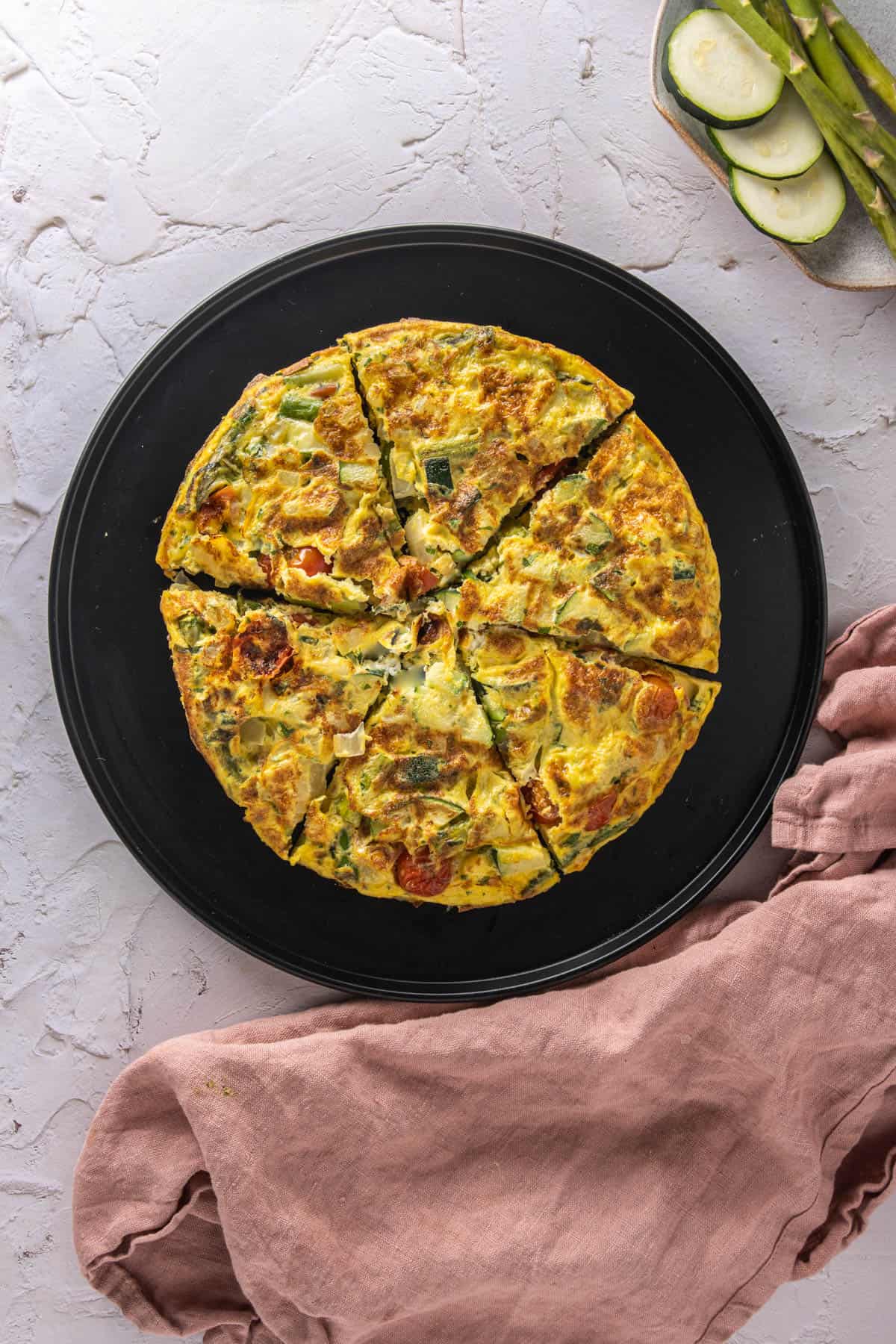
This post contains helpful tips and tricks! If you're in a rush, please use the "Jump to Recipe" below!
💭 Why you'll love this recipe
- Quick and convenient. It's the OG one pan / skillet recipe and takes only 30 minutes, with minimal active effort!
- Super nutritious. This dish is loaded with vegetables and protein from eggs so you're getting a range of nutrients and not as many calories!
- Very customizable. It's a really forgiving recipe with leftover vegetables you have in the fridge (though I've used spring veggies!)
- Use up a lot of eggs. If you're looking for a great recipe that uses up a lot of eggs, this one uses up six eggs, and has notes for scaling further. If you want to learn more about what different labels mean on eggs (e.g., pasture-raised, omega-enriched) check out this egg label guide!
- Stovetop and baked versions. Traditional Italian frittatas are also cooked entirely on the stovetop, but sometimes it's easier to finish in the oven so I have both sets of instructions! I use a non-stick skillet for the stovetop version (non negotiable!) and an ovenproof skillet (like a cast iron!) for the baked version. If you want something hearty, check out this farmers strata too.
📋 Ingredients and notes
This is a simple spring vegetable frittata. You'll need 2 cups of chopped vegetables of your choice. I've used zucchini, asparagus, onions, and cherry tomatoes for my version. You'll need six eggs, olive oil, cheese (I've used a combination of goat cheese, and vegetarian parmesan) and a fresh herb garnish as well.
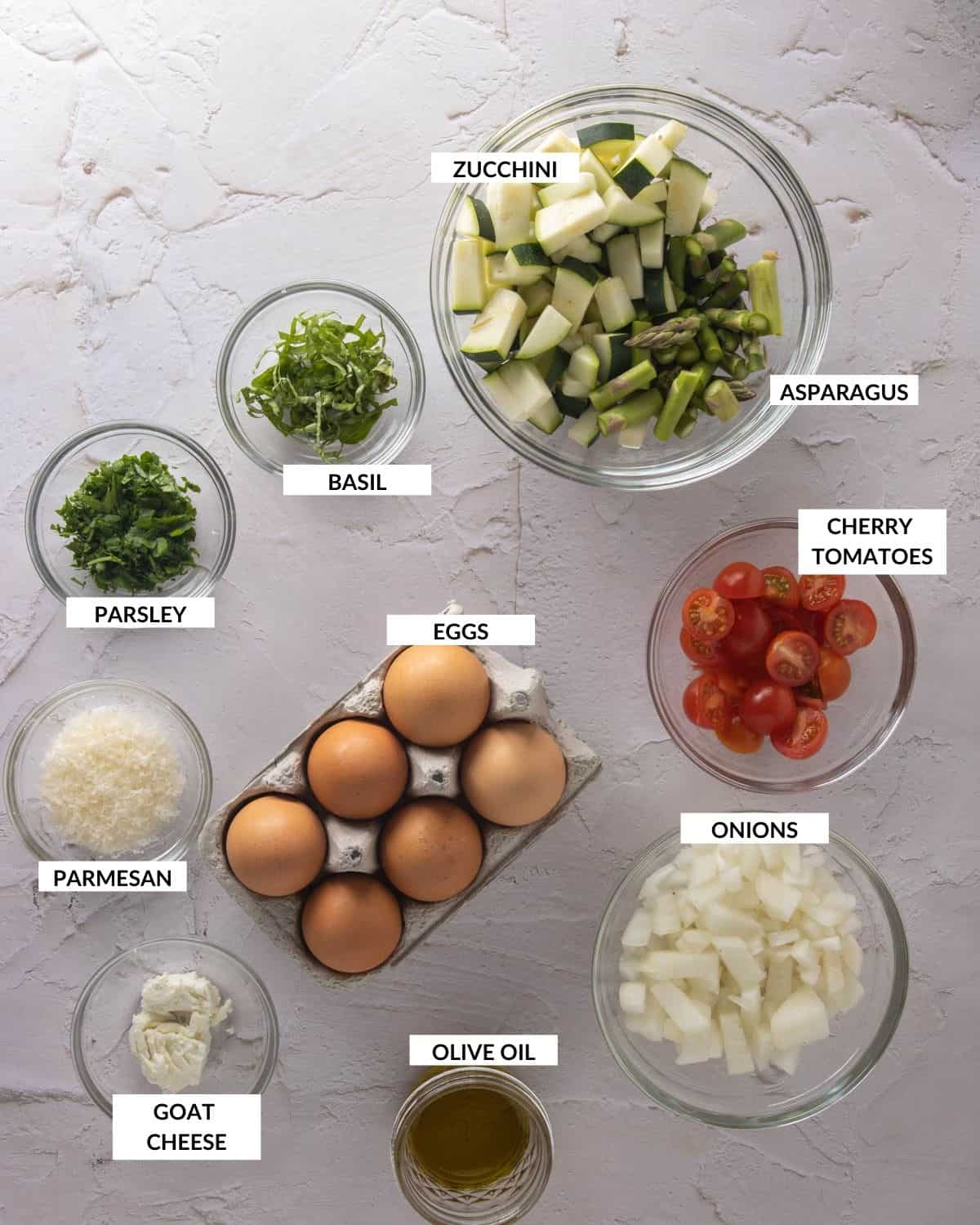
Notes and Variations
- Make it vegan. This recipe can use eggs or an egg substitute like Just Eggs. So to make it vegan, swap the eggs, leave out the heavy cream, and use vegan feta cheese and nutritional yeast for the umami flavors.
- Use leftover or cooked vegetables. You can easily swap the veggies with precooked versions (or leftovers) - use 1.5 cups if going this route.
- Vegetable combinations. I updated this recipe during the springtime, so I've used a spring vegetable medley. There are many excellent combos you can use - mushroom and spinach, traditional potato frittata, or to be honest, whatever is in your fridge! If you want to use your zucchini up in a different way though, try these zucchini fries - absolutely delicious!
📖 Step-by-step instructions
Whisk the eggs and chop up the vegetables
Start by cracking six eggs into a roomy mixing bowl and whisk them really well. The more you whisk the better, since you want to aerate the eggs as much as possible. One trick I use here is to crack three eggs at a time into a glass, and use a fork to whisk. Then I transfer them to a mixing bowl and then whisk again using a balloon whisk.
Chop up about 6 ounces of vegetables (approximately two cups). I've used a combination of zucchini, asparagus, cherry tomatoes, and red onions in this recipe. Keep reading for other variations. You'll want to get this to a small dice - that is, the size of an actual dice. The smaller the vegetables, the better it'll cook on stovetop!
Finely shred or grate half an ounce of parmesan cheese, and also add about half an ounce of goat cheese for creaminess. Chop up some fresh herbs of choice (I've used a chiffonade of basil and chopped parsley). Add vegetables, cheese, and a tablespoon of finely chopped fresh herbs into the egg mixture and give it a good mix.
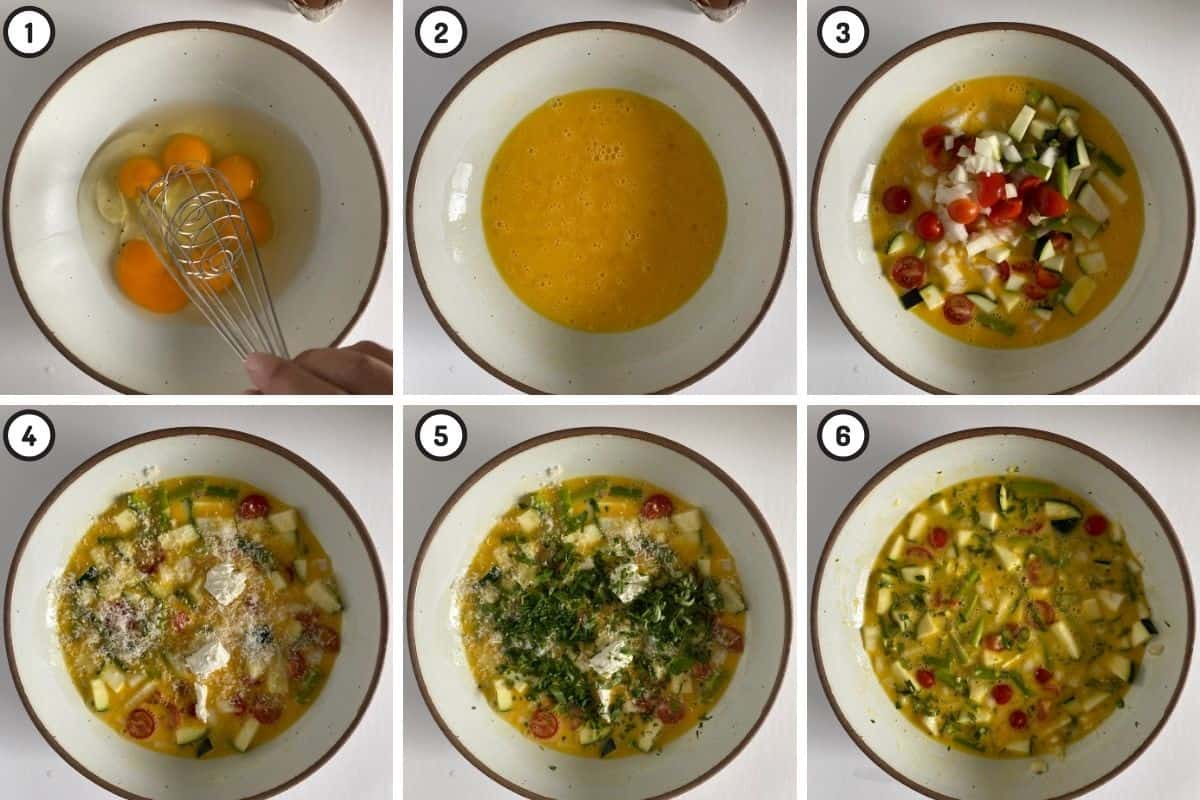
Stovetop frittata: Cook egg mixture on one side and then flip twice to finish!
Let's cover the stovetop version first. Use a 10" skillet or fry pan, and heat up a tablespoon of oil on medium heat. Swivel the oil so it covers the full width of the pan. Pour the egg mixture into the skillet and move it around with a silicon spatula for about 30 seconds. Then let it cook and settle for about a minute.
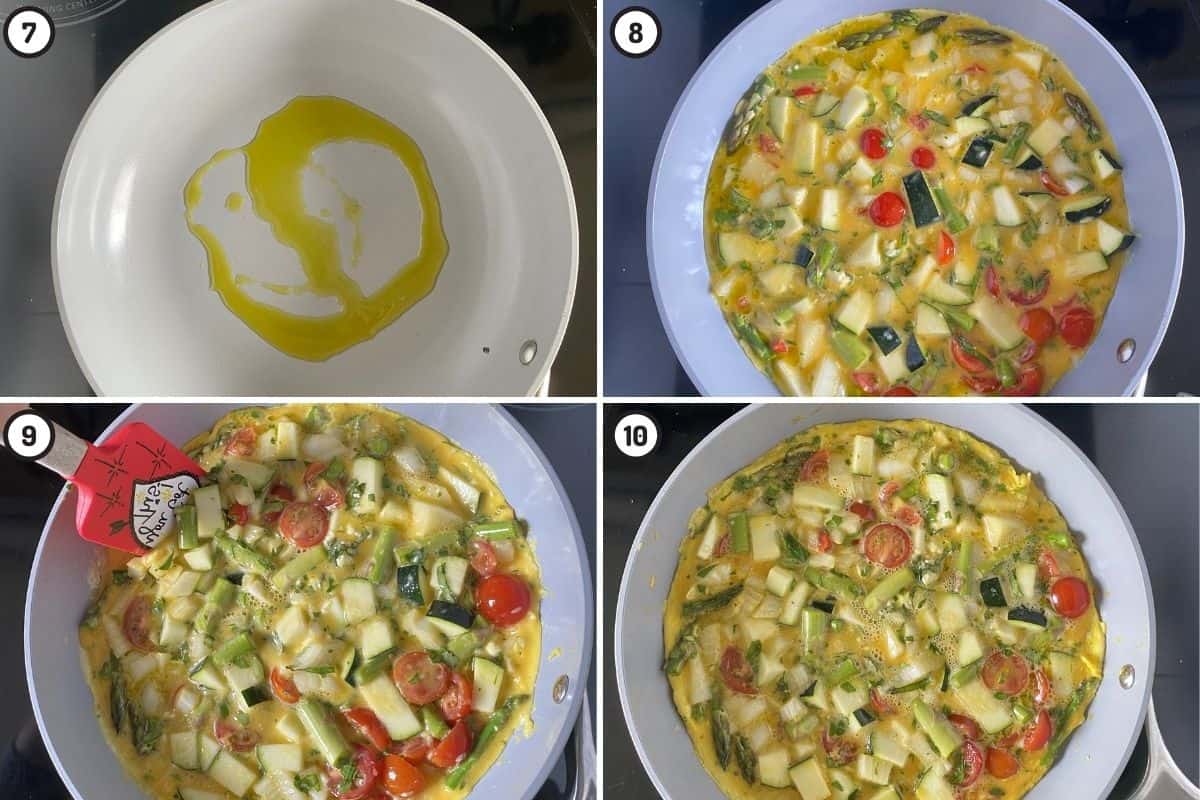
Then, once the edges are somewhat set, try to cook as much of the egg as possible by moving the mixture around. One trick I use here (thanks to Bon Appetit) is to lift one of the edges, and gently tilt the skillet a bit to allow liquid portion to flow to the bottom and cook for about 5 minutes.
Remember: you want to get AS MUCH of the eggs cooked as possible on one side before flipping.
Then, once the eggs are mostly cooked, shake the skillet to loosen the frittata a bit. Cover the skillet with a plate larger than the skillet, and then flip the frittata onto the plate. Then, oil the skillet again, and gently, using a silicon spatula, place the frittata back onto the skillet to cook the other side. You'll lose some of the liquid eggs while transferring but that's okay!
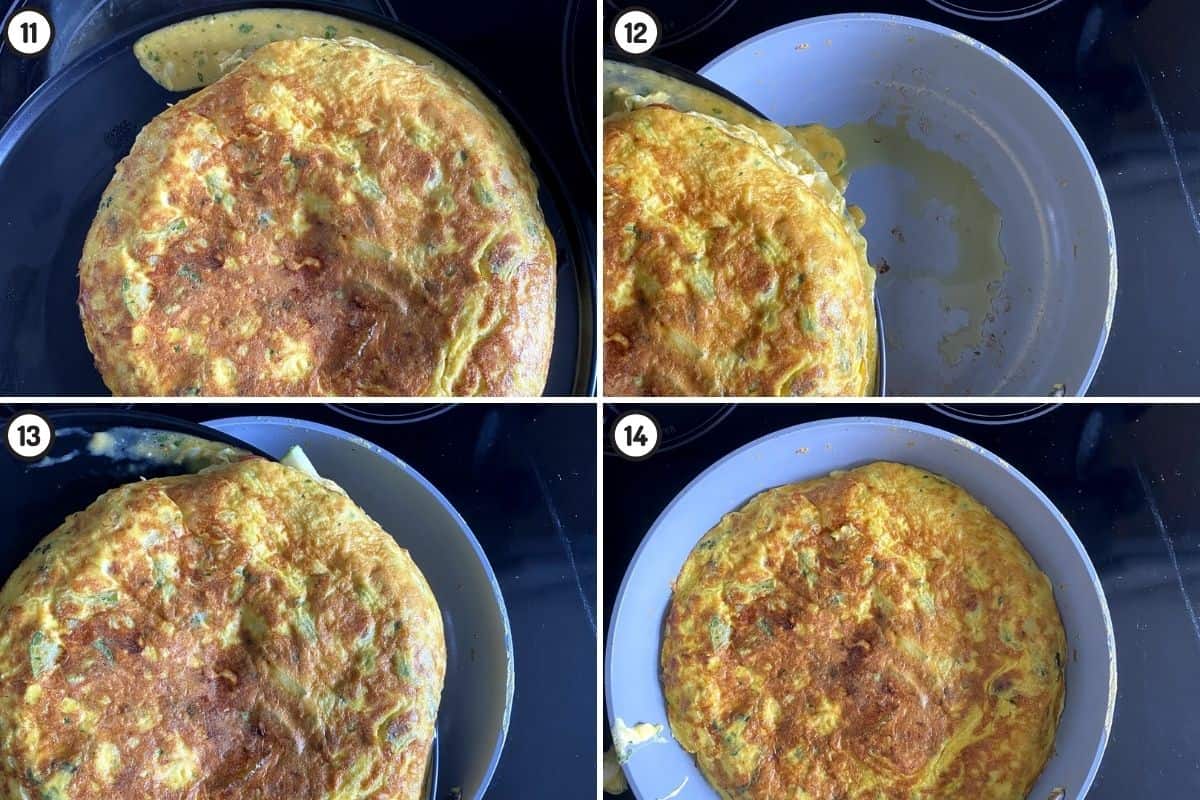
Cook the other side for about 2 to 3 more minutes. Then, flip the frittata onto the serving surface (whether that's a cutting board or a plate!)
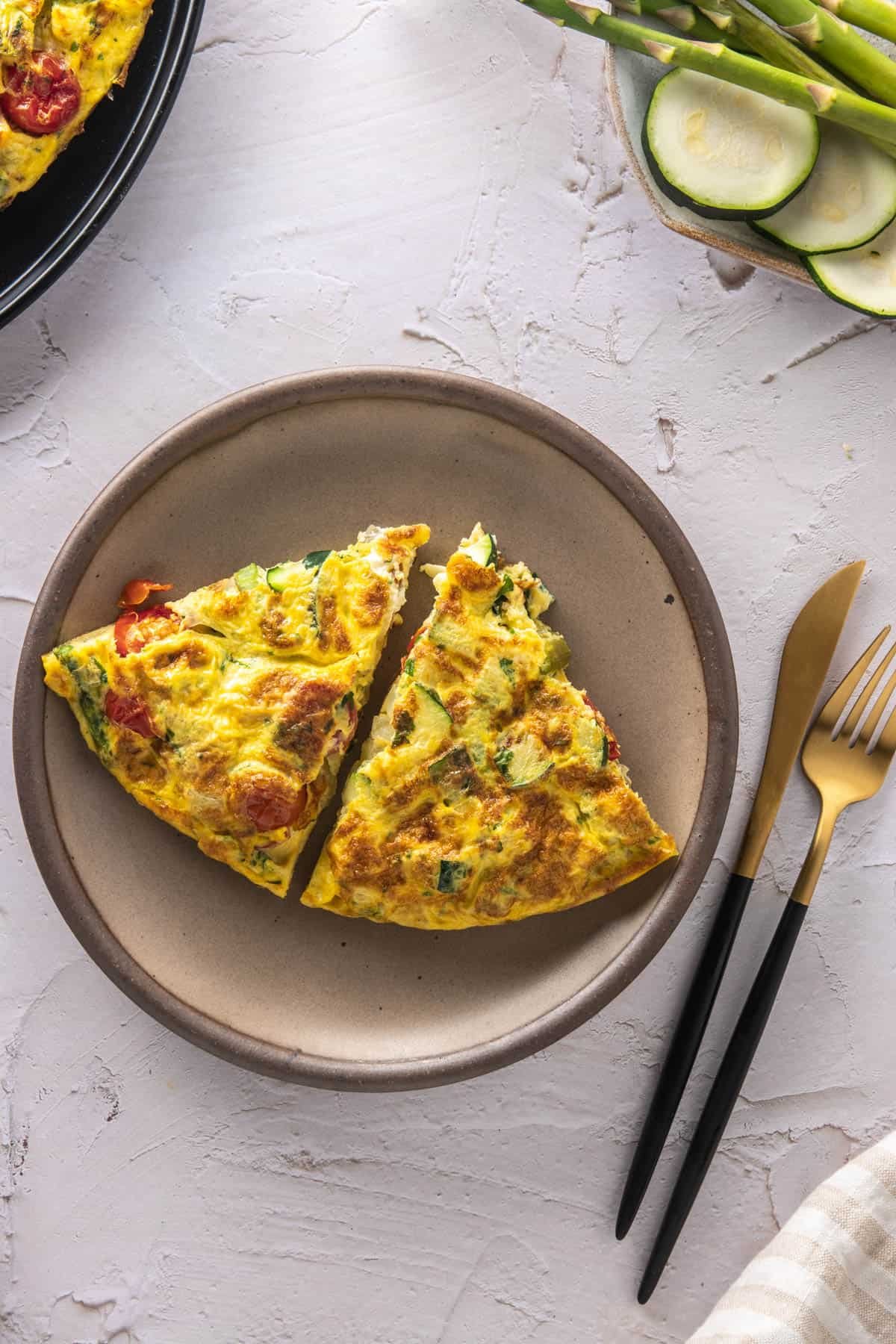
Stovetop then oven: Cook egg mixture halfway and finish by baking in the oven!
Remember to use an oven proof skillet if you're going this way. Start by preheating the oven to 400°F. Then, oil an oven proof skillet (I typically use an 10" skillet) and then add the chopped vegetables to the skillet. Cook for about 2-3 minutes.
Add the whisked eggs along with the cheese and herbs, shake to spread the mixture through the pan.
Then, bake the egg mixture in the oven for about 15 to 20 minutes until the eggs are fully set. Your frittata is ready to serve!
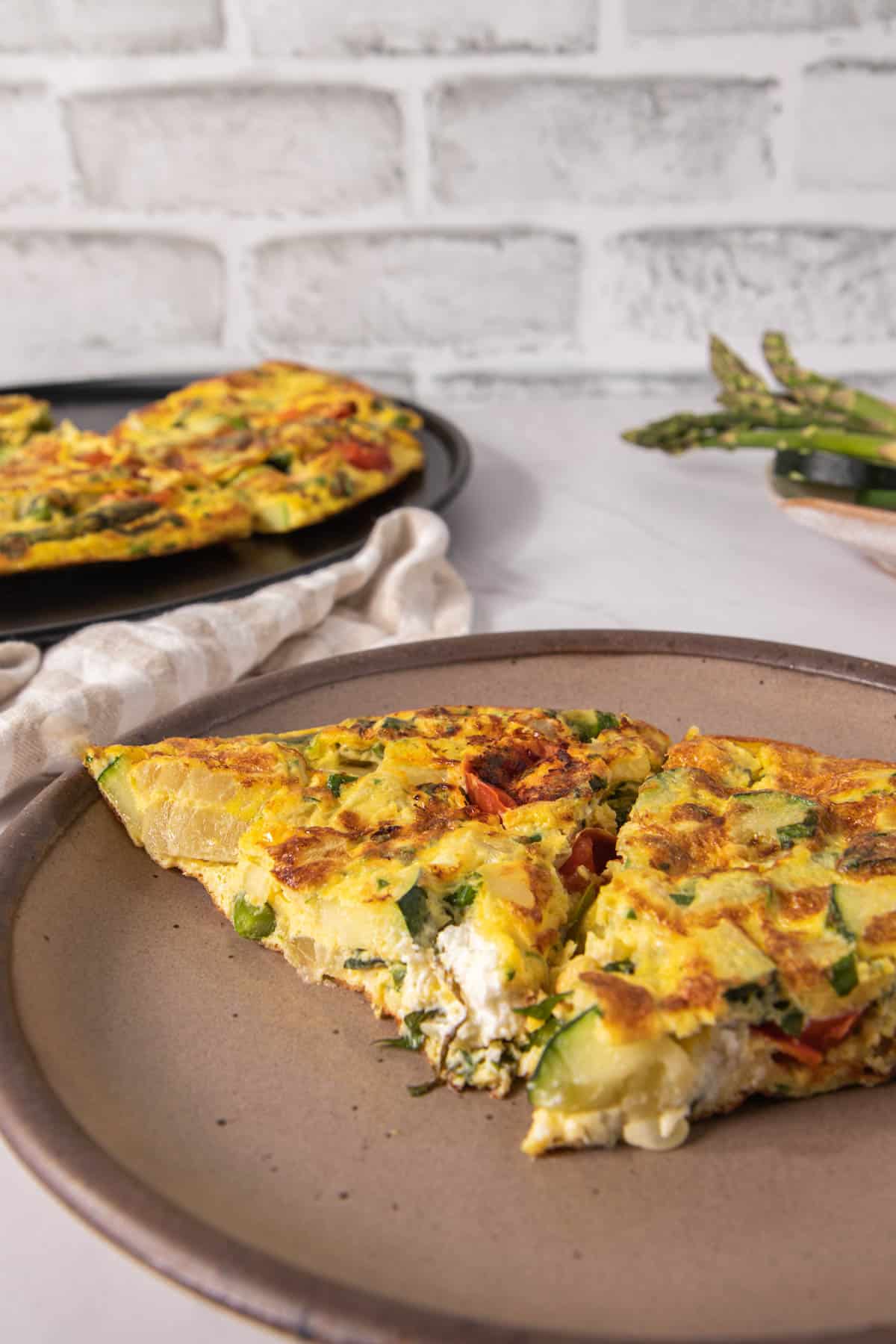
👩🏽🍳Top tips and FAQs
I have four top tips to help you avoid some of the most common mistakes and get a perfect, fluffy frittata the first time you make one.
- Use the right skillet. Non-stick or cast iron skillets are the way to go and will help prevent the dish from sticking to the bottom of the pan. Avoid stainless steel in this case if you can!
- Scale the frittata right, avoid pancakes! The smaller the skillet, the fluffier your frittata. You'll want 2 eggs for a 6 inch skillet, 4 for an 8 inch skillet, or 6 eggs for a 10 inch skillet (this recipe)
- Avoid burning the bottom of your frittata through heat control. You'll want to make sure you add your eggs on a medium-low heat to avoid browning the bottom too much.
- Use the right type of ingredients and cheeses. Frittatas are super forgiving, but I try to diversify the textures and tastes of the toppings. Sharp, salty, and creamy goat cheese, umami from Parmesan, sweetness from zucchini and tomatoes, and crunch from onions and asparagus!
Troubleshooting and FAQs
Frittatas are super easy to make but I also get a lot of questions so I compiled all of them here to help you troubleshoot!
If you're making a stovetop frittata, I HIGHLY recommend using a non-stick skillet (since you'll have to flip the frittata!) If you're going the stovetop-then-oven route, I recommend a cast iron skillet!
Frittata typically uses very little dairy - occasionally, a couple of tablespoons of full fat dairy is added for creaminess but not more!
The key is to use a non-stick pan and cook the eggs as much as possible on one side first. Then, shake the skillet to loosen the frittata, cover the skillet with a slightly larger plate, and then flip it.
When you make an omelet, you cook the eggs first and then fold in the vegetables or the filling in the center. In a frittata, you directly add the filling into the egg mix and cook it together.
There are three main differences. Frittata is Italian, while quiche is French. Quiches also typically have a crust while frittatas never do. Finally, frittatas use little to no milk, while quiches have an egg custard filling, made with eggs and dairy.
When you finish cooking the frittata, it'll most likely go flat after a while. Typically, as you're cooking, air and moisture in the egg help it expand, and the expanded gases help provide the structure. This starts to go away once it starts cooling down. As a rule of thumb, I expect frittatas to deflate by a third once they start cooling!
🍴 Serving and storage suggestions
Leftover frittata can be stored in the fridge for a couple of days. I store them in airtight containers and then serve them chilled, or warm up individual slices in the microwave! I don't suggest freezing them (they get really gummy).
If you're interested in make-ahead frittatas: I'd make the egg mixture and store in the fridge, and then you can pour into a skillet or muffin tin to bake right before you need them.
Frittata toppings: The beauty of the frittata is that you can literally use any vegetables you have in your fridge to make it more hearty. I typically tend to use some combination of green vegetables (like spinach, broccoli, arugula) with cheese (feta, cheddar, goat cheese), and some crunchy vegetables like carrots or peppers for color and diversity.
You can serve frittatas by themselves, or with a nice healthy side salad (like this roasted beet salad, or a simple mango avocado salad) or a more hearty side (like these mashed potatoes)
If you like this recipe, check out my other eggy breakfast recipes:
If you tried this recipe, don't forget to comment and rate! ⭐⭐⭐⭐⭐
📖 Recipe
Zucchini and Asparagus Frittata (Stovetop and Baked!)
Ingredients
- 2 tablespoons olive oil, divided
- ½ cup zucchini, diced, approx. half a medium zucchini
- ½ cup asparagus, diced, approx. 6-8 stalks of asparagus
- ½ cup cherry tomatoes, quartered
- ½ cup red onions, diced or cut into thin slices
- 6 large eggs
- ½ oz goat cheese
- ½ oz parmesan, shredded
- 1 tablespoon basil, chiffonade
- 1 tablespoon parsley, chopped finely
Instructions
Prepare Egg Mixture
- Crack six eggs into a mixing bowl and whisk well with a fork or whisk. The more you whisk the better, since you want to aerate the eggs as much as possible.
- Chop 6 ounces of vegetables into a fine dice. This is roughly ½ cup each of zucchini, asparagus, cherry tomatoes, and red onions. You can use any combination of vegetables you choose (for instance, just one medium zucchini and some cherry tomatoes, or just asparagus). Add to the whisked eggs.
- Finely shred half an ounce of parmesan cheese, and add that along with half an ounce of goat cheese into the eggs. Chop up two tablespoons of fresh herbs of choice (I've used a chiffonade of basil and chopped parsley) and add this to the eggs as well. Whisk the mixture thoroughly. Set aside.
Stovetop Instructions
- Place a 10" non-stick skillet on the stove, and heat on medium-low heat. Add a tablespoon of olive oil and swivel it around the skillet to spread evenly.
- Pour the egg mixture into the skillet and use a silicon spatula to make sure it spreads across the skillet. Initially agitate the egg mixture to start cooking it, and then allow the edges to set, about 1 minute or so. Then, slowly lift the set edges with a spatula and gently tilt the skillet to allow some of the uncooked eggs to drizzle down to the bottom. The key is to get the eggs cooked as much as possible before flipping. Then, allow it to cook for 5 minutes or so.
- Once the eggs are about 80 to 85% cooked, shake the skillet or slide the spatula underneath the edges to loosen it. Then, cover the skillet with a plate that's larger than the skillet, and flip the frittata gently onto the plate.
- Add a tablespoon of olive oil again to the skillet and swivel to coat. Then, gently slide the frittata back onto the skillet and allow the uncooked side to cook for about 3 minutes. Turn the heat off, and allow to cool for a few minutes. Then, use a serving plate or cutting board to flip the frittata back. Cut it up into neat slices and serve hot!
Oven Instructions
- Preheat oven to 400°F. Place a 10" cast iron skillet on the stove, and heat on medium-low heat. Add a tablespoon of olive oil and swivel it around the skillet to spread evenly.
- Add the egg mixture and use a silicon spatula to make sure it spreads across the skillet. Then, once it's evenly spread, place the skillet in the oven and cook for about 15 to 20 minutes until the eggs are set. When done, you should be able to pass a fork through the frittata cleanly.
- Allow it to cool down for a minute or two but serve hot!
Notes
- Use the right skillet. Non-stick or cast iron skillets are the way to go and will help prevent the dish from sticking to the bottom of the pan. Avoid stainless steel in this case if you can!
- Whisking eggs: One trick I use here is to crack three eggs at a time into a glass, and use a fork to whisk. Then I transfer them to a mixing bowl and then whisk again using a balloon whisk.
- Stovetop without flipping: One other way to make a frittata on the stovetop without flipping is to cook the eggs covered initially. If you cover the skillet at the beginning, and cook for about 5-7 minutes total, you should get a softer frittata without flipping!
- Scale the frittata right, avoid pancakes! The smaller the skillet, the fluffier your frittata. You'll want 2 eggs for a 6 inch skillet, 4 for an 8 inch skillet, or 6 eggs for a 10 inch skillet (this recipe)
- Avoid burning the bottom of your frittata through heat control. You'll want to make sure you add your eggs on a medium-low heat to avoid browning the bottom too much.
- Use the right type of ingredients and cheeses. Frittatas are super forgiving, but I try to diversify the textures and tastes of the toppings. Sharp, salty, and creamy goat cheese, umami from Parmesan, sweetness from zucchini and tomatoes, and crunch from onions and asparagus!
Nutrition
Note: This recipe was originally published on January 4, 2020. It was updated on May 18, 2021 with additional tips and tricks, and both stovetop and oven-baked methods.
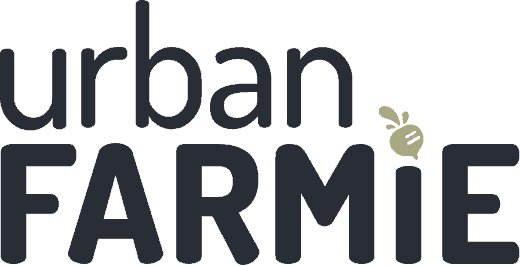


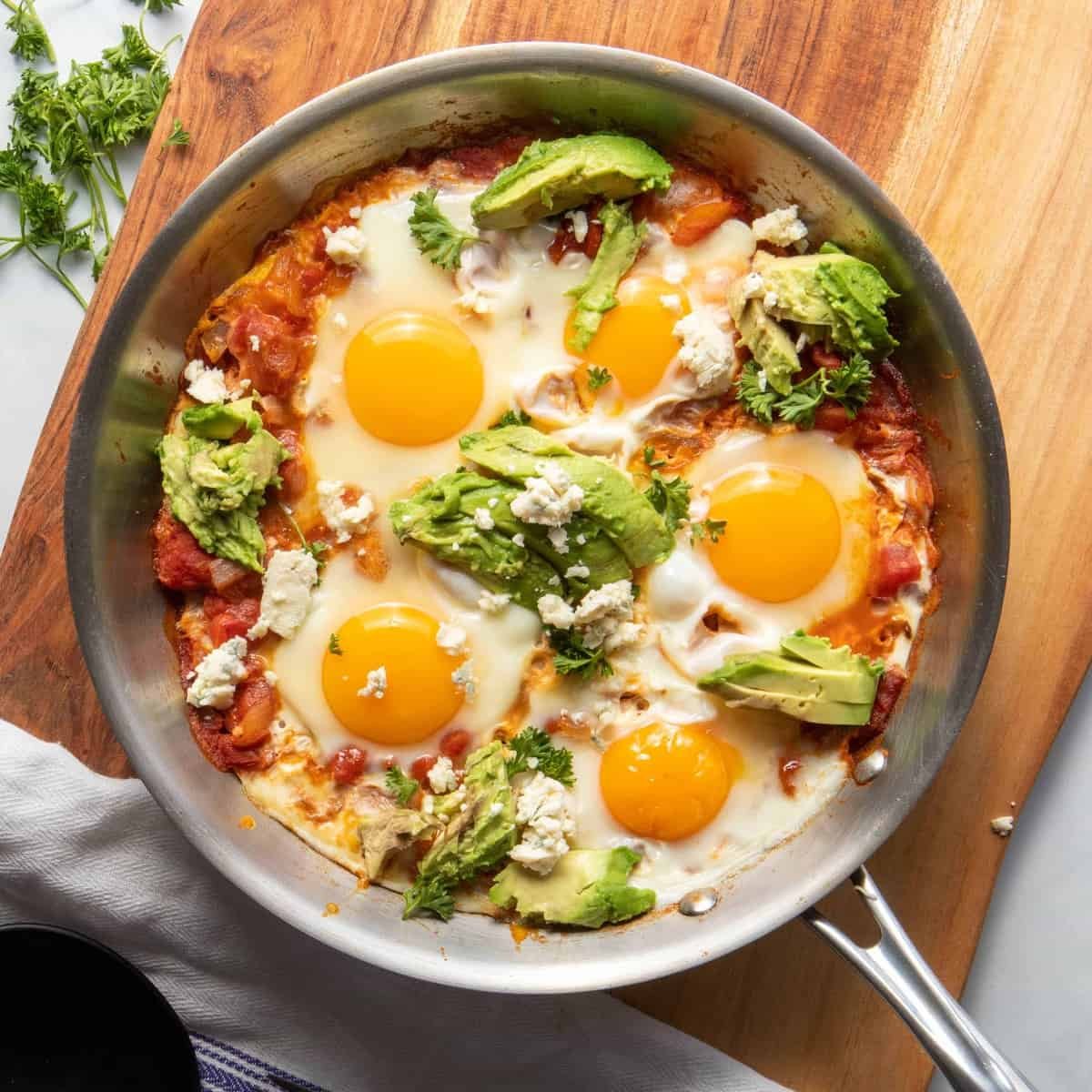
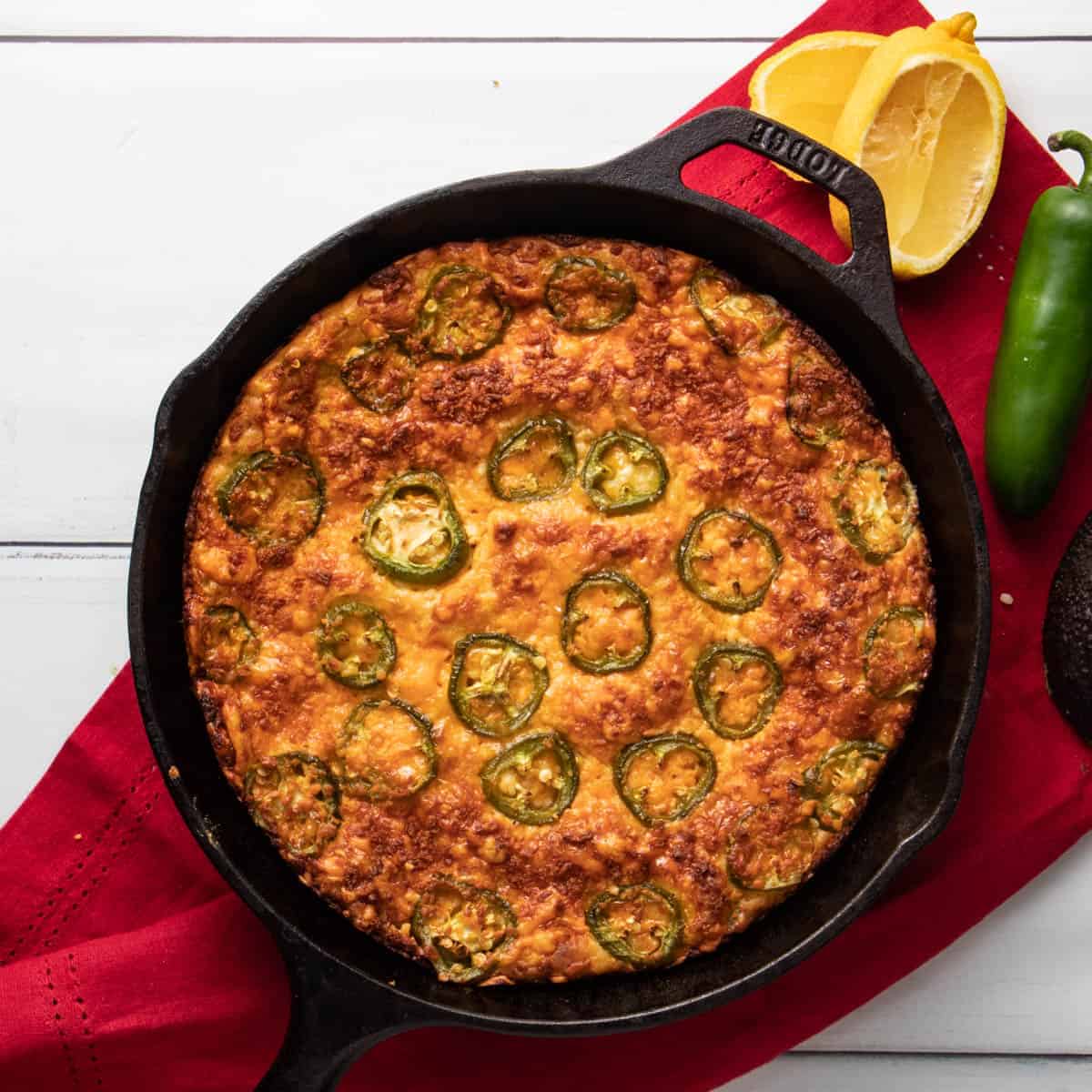
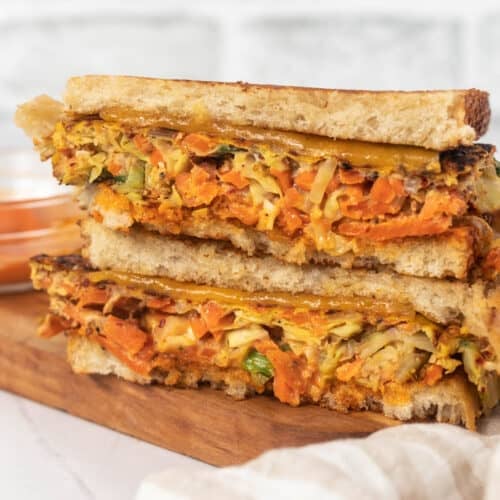
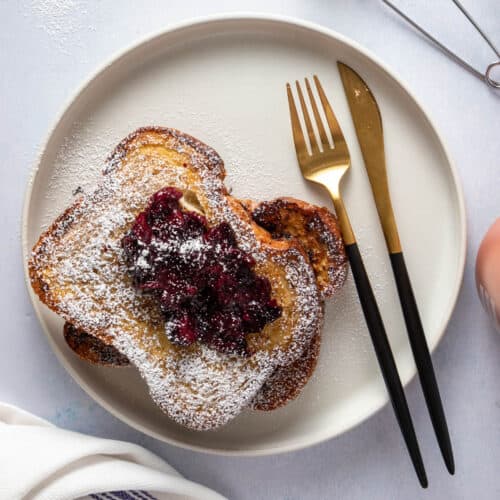









Comments
No Comments